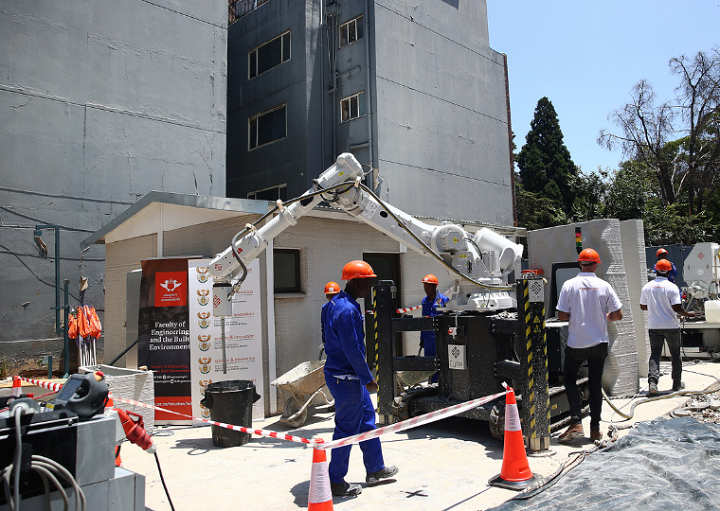In 3D Printing News Briefs today, Artec 3D has opened a new production facility for optoelectronics in Luxembourg, while Axial3D opened a new medical 3D printer center of excellence. Mycorena and Revo Foods received €1.5 million to 3D print mycoprotein to replace seafood, and the first 3D printed building in South Africa has been launched. Finally, 3D printed samples by Orion Additive Manufacturing are on their way to the moon.
Artec 3D Opens Optoelectronics Production Facility in Luxembourg
 The opening of this new state-of-the-art production facility marks the start of a new chapter for Artec 3D. Photo: Nataliia Arintcina
The opening of this new state-of-the-art production facility marks the start of a new chapter for Artec 3D. Photo: Nataliia ArintcinaProfessional 3D hardware and software manufacturer Artec 3D recently opened a new high-tech production facility for optoelectronics in Luxembourg, welcoming honored guests Prime Minister Xavier Bettel and Minister of Economy Franz Fayot to the inauguration of the site. The facility features a 300m² clean zone with an ISO7 cleanliness classification and customized temperature, pressure, and humidity control, decentralized air systems, and data intelligence software that provides real time insight into the status of the cleanroom, all of which ensure a high standard of production and the highest levels of precision and safety. At the new facility, Artec 3D will manufacture and assemble its award-winning 3D scanners, used for many industries and applications, including by the Luxembourg Defense Directorate to scan forensic evidence to document possible war crimes in Ukraine.
“We’re very proud to open the most sophisticated fab in Luxembourg, and one of the best in Europe to produce highly capable electronics working with very small components and very high frequencies. Our PCB (electronics) assembly line is fully automatic, and consists of the latest and best production and quality inspection machines from Japan, South Korea, Germany, Italy, and the USA,” said Artyom Yukhin, CEO and President of Artec 3D.
“This new state-of-the-art facility marks the start of a new chapter for Artec and our increased ability to deliver new products as we go forward. Our thanks go to Luxembourg Prime Minister Xavier Bettel and Luxembourg Minister of the Economy Franz Fayot for opening our new facility and celebrating this significant milestone with us.”
Axial3D Opens Medical 3D Printing Center of Excellence in Belfast
Speaking of new facilities, Irish 3D printing and AI-powered medical segmentation company Axial3D announced the grand opening of a new medical 3D Printing Center of Excellence in Belfast. The facility will increase access to the company’s realistic 3D printed anatomical models for even more hospitals, medical research companies, and medical device manufacturers. Axial3D’s cloud-based segmentation service easily turns 2D medical images into accurate, patient-specific 3D models, which are then 3D printed using Stratasys technology for use in simulation, device testing, pre-surgical planning, and more. At the new Center of Excellence, Axial3D will also be able to produce and provide models that mimic human bone and tissue.
“When I founded Axial3D, our goal was to make patient-specific care routine and our new centre will allow us to help more clinicians and surgeons improve patient outcomes and provide medical device companies an affordable way to accelerate their patient specific programs. The opening of our new Medical 3D Printing Centre of Excellence represents a significant milestone for our company and for the field of medicine, allowing us to continue pushing the boundaries of what is possible with 3D printing technology,” said Axial3D’s Founder and CSO Daniel Crawford.
Mycorena & Revo Foods Receive €1.5 Million Grant
 Revo Foods salmon, courtesy
Revo Foods salmon, courtesyMoving on, several months ago Revo Foods and Mycorena announced that they were partnering to 3D print mycoprotein to replace seafood. This partnership has now led to a €1.5 million grant for their work from EU funding program Eurostars; the Austrian Research Promotion Agency; and Swedish innovation agency Vinnova. Mycoprotein was chosen largely because of its soft, fibrous texture, which works for the texture and taste of traditional seafood, and while fiber 3D printing is often tricky, Mycorena’s proprietary process makes it easier. According to the Good Food Institute APAC, alternative seafood producers raised over $175 million in 2021, which was up 50% from 2020, so it’s clear that the demand for vegan seafood is high. The grant will support research into scaling their mycoprotein technology, and Paulo Teixeira, Chief Innovation Officer at Mycorena, said the recognition emphasizes the value of their technology, which is an important part of developing a sustainable food system.
“We are really happy for the opportunity to explore the exciting new ingredient of mycoprotein in our production process. Mycorena is a leading company in this space, and together with our new process technology for whole-cut alternatives, we believe that we can bring seafood alternatives and additive food manufacturing as a whole to the next level,” said Niccolo Galizzi, head of product development at Revo Foods.
“First” 3D Printed Building in South Africa
South Africa’s Department of Science and Innovation and the University of Johannesburg are partnering to launch the country’s “first” 3D printed building. Last year, the Mampeule Foundation, another project partner, donated R5 million to the university’s School of Engineering and the Built Environment (SMaCT), which was established in 2021 to lead research pertaining to sustainable alternative modern and cost-efficient construction technologies. The foundation works to uplift and equip SA youth with the aptitude to help the country become a leader in applying “4IR technologies” as a way to address socioeconomic issues. Rali Mampeule, the founding Chairperson of the foundation and CEO of the SA Housing and Infrastructure Fund (SAHIF), says he’s experienced the high cost of construction materials, and construction itself, through SAHIF, and that these expenses make it almost impossible for low- and middle-income people to afford their own accommodations. That’s why it’s so important to invest in R&D and new technology, like concrete 3D printing, that can enable alternative, less expensive, and viable construction methods. Other project partners were cement supplier AfriSam and the KwaZulu-Natal Department of Human Settlements.
“The 3D houses themselves will ideally be more resilient, more energy-efficient and less expensive. To make housing more affordable in South Africa we need the introduction of modern alternative building technologies to deliver on the target of more housing opportunities – at least 2 million more additional units. This shortage of housing has a range of complex causes, including the high cost of construction which rose even further due to the Covid-19 pandemic and supply constraints,” Mampeule said.
“The developing world, including South Africa, continues to face many substantial developmental challenges which can be more expeditiously addressed if we embrace 4IR technology. In fact, South Africa must not only embrace 4IR but develop local expertise that it can use it to accelerate our fight against unemployment, poverty, and inequality.”
Orion AM’s 3D Printed Samples Heading for the Moon
 The 3D printed components bonded to the Rashid rover’s wheels prior to launch. Image credit: ESA/MBRSC
The 3D printed components bonded to the Rashid rover’s wheels prior to launch. Image credit: ESA/MBRSCThe European Space Agency (ESA) announced that the first European technology to make contact with the surface of the moon will include several 3D printed samples by Berlin startup Orion Additive Manufacturing. Two years ago, the startup began working with the ESA’s European Space Research and Technology Centre (ESTEC) on this project that’s bringing what are supposedly the first 3D printed parts to land on the moon. The samples were 3D printed out of conductive PEEK, using Orion AM’s proprietary process, and are mounted on the wheels of the Rashid rover for the Emirates Lunar Mission’s “Material Adhesion and Abrasion Detection” experiment, which is testing how resistant different materials are to the lunar environment. Dr. Ugo Lafont, Space Materials Engineer at ESA, chose Orion AM to print the PEEK samples for the mission, as the startup is “particularly adept at 3D printing in PEEK,” and he’s not wrong—the material, when undergoing internal testing at ESA-ESTEC, resulted in mechanical properties up to 87% higher than those achieved with a non-PEEK optimized AM technology.
“These unique and special materials, which are challenging to 3D print while maintaining their superior material properties, are exactly why we developed our A150 additive manufacturing system. Our system allows these materials to easily be processed into end-use and space-ready components, and function to their full potential regardless of loading direction or environment. We are very grateful to have been selected by ESA to contribute to this project. We have developed this technology over the last 5 years, and are proud to announce this achievement – it is truly a dream come true to have 3D printed parts from Orion AM on the moon!” said Adam Rumjahn, the managing director of Orion Additive Manufacturing.
“Our goal is to update material data sheets with 3D-printed data using Orion AM’s process so that the industry can be convinced that it is possible to 3D-print high-performance polymers without compromises. This will ultimately drive adoption of our additive manufacturing for end-use parts in the industry, in space, and in the medical sector as well.”
The mission is expected to make first contact with the surface of the moon in April of 2023.
Subscribe to Our Email Newsletter
Stay up-to-date on all the latest news from the 3D printing industry and receive information and offers from third party vendors.
You May Also Like
Gorilla Sports GE’s First 3D Printed Titanium Cast
How do you help a gorilla with a broken arm? Sounds like the start of a bad joke a zookeeper might tell, but it’s an actual dilemma recently faced by...
Nylon 3D Printed Parts Made More Functional with Coatings & Colors
Parts 3D printed from polyamide (PA, Nylon) 12 using powder bed fusion (PBF) are a mainstay in the additive manufacturing (AM) industry. While post-finishing processes have improved the porosity of...
$25M to Back Sintavia’s Largest Expansion of Metal 3D Printing Capacity Since 2019
Sintavia, the digital manufacturing company specializing in mission-critical parts for strategic sectors, announced a $25 million investment to increase its production capacity, the largest expansion to its operations since 2019....
Velo3D Initiates Public Offering in a Bid to Strengthen Financial Foundations and Drive Future Growth
Velo3D (NYSE: VLD) has been among a number of publicly traded 3D printing firms that have attempted to weather the current macroeconomic climate. After posting a challenging financial report for 2023,...































